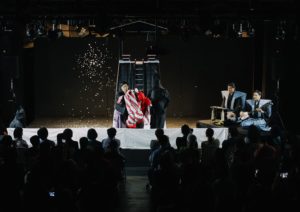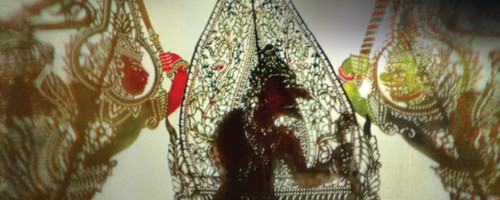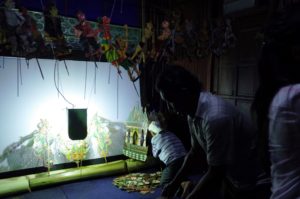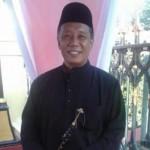Kelantan will come alive with the magic of puppetry as the state hosts a travelling troupe of Bunraku performers for the first time ever in a joint demonstration with masters of Wayang Kulit at Desasiswa Nurani, Universiti Sains Malaysia, this 12 July.
Designated by the Japanese government as an Intangible Cultural Property and by UNESCO as a World Intangible Cultural Heritage, Bunraku features lavishly costumed large puppets, manipulated by three onstage puppeteers (ningyotsukai) apiece in a surreally lifelike fashion. The action is accompanied by a narrator (tayu) who recites the dialogue and takes on the personality of several characters, while shamisen players enhance the atmosphere of the drama with their three-stringed lutes.
The visit is the latest in the group’s years-long effort to introduce the centuries-old theatrical art to Malaysian audiences. Since 2013, its members have made debut appearances in Kuala Lumpur, Penang, and Johor?each time collaborating with keepers of the flame of local puppetry traditions.
2017 sees them taking their evocative blend of sophisticated storytelling and technical prowess to Kelantan, the heartland of Wayang Kulit, where they will share the spotlight with shadow play master Pak Rahim bin Hamzah. The son of the country?s best known dalang (puppeteer), Hamzah bin Awang Amat, he continues using the same collection of puppets and musical instruments that had belong to his father.
The evening?s programme will be preceded by the seven-strong Japanese ensemble before passing the floor to Pak Rahim and his troupe, Hamzah Palawit. All of them will then end the show together in a joint presentation, taking cues from one another?s repertoire of signature moves for a richly diverse cross-cultural exchange.
The event is co-organised by The Japan Foundation, Kuala Lumpur (JFKL) and the Kelantan office of the National Department for Culture and Arts (JKKN) with the cooperation of academic-cum-writer Prof. Dato? Dr. Ghulam-Sarwar Yousof.
Date & Time: Wednesday, 12 July 2017, 8.30 p.m.
Admission: Free
Venue: Desasiswa Nurani, Kampus Kesihatan, Universiti Sains Malaysia, 16100 Kubang Kerian, Kelantan
BUNRAKU
 Ranking with Noh and Kabuki as one of Japan?s foremost stage arts, the Ningyojoruri Bunraku puppet theatre is a blend of sung narrative, shamisen music and puppet drama. This theatrical form emerged during the early Edo period when puppetry was coupled with Joruri, a popular fifteenth-century narrative genre. The plots related in this new form of puppet theatre are derived from two principal sources: historical plays set in feudal times (Jidaimono) and contemporary dramas exploring the conflict between affairs of the heart and social obligation (Sewamono). Approximately 160 works out of the 700 plays written during the Edo period have remained in today?s repertory. There currently exist numerous Bunraku schools nurturing the next generation of performers, as the aesthetic qualities and dramatic content of the plays continue to appeal to modern audiences.
Ranking with Noh and Kabuki as one of Japan?s foremost stage arts, the Ningyojoruri Bunraku puppet theatre is a blend of sung narrative, shamisen music and puppet drama. This theatrical form emerged during the early Edo period when puppetry was coupled with Joruri, a popular fifteenth-century narrative genre. The plots related in this new form of puppet theatre are derived from two principal sources: historical plays set in feudal times (Jidaimono) and contemporary dramas exploring the conflict between affairs of the heart and social obligation (Sewamono). Approximately 160 works out of the 700 plays written during the Edo period have remained in today?s repertory. There currently exist numerous Bunraku schools nurturing the next generation of performers, as the aesthetic qualities and dramatic content of the plays continue to appeal to modern audiences.
Ningyojoruri Bunrakuza










 Firmly rooted in the history of the Malay archipelago, Wayang Kulit finds a solo puppeteer, known as dalang, manipulating and providing voices for two-dimensional figures cut from animal hide and painted on both sides. The shadows of these puppets are projected onto a taut linen screen by coconut oil lamp or electric light. Performances are complemented by a gamelan orchestra, numbering upwards of 10 musicians. Most plays are based on the ancient Indian epics Mahabharata and Ramayana, or folklore native to the region.
Firmly rooted in the history of the Malay archipelago, Wayang Kulit finds a solo puppeteer, known as dalang, manipulating and providing voices for two-dimensional figures cut from animal hide and painted on both sides. The shadows of these puppets are projected onto a taut linen screen by coconut oil lamp or electric light. Performances are complemented by a gamelan orchestra, numbering upwards of 10 musicians. Most plays are based on the ancient Indian epics Mahabharata and Ramayana, or folklore native to the region. Born in 1962, he is the son of Malaysia?s best known dalang Hamzah bin Awang Amat, who won the prestigious National Arts Award as well as other forms of international recognition for his expertise in Kelantanese Wayang Kulit. Initially trained by his father for a short duration in 1978, he then left to work outstation before returning to the art form in 1990. He came under the tutelage of another popular dalang, Pak Yusoff, who also trained apprentices of different nationalities. In 2008, Rahim established his own troupe, naming it Hamzah Pawalit, thus making it in some ways an extension of his father?s legacy and family trade. He has since been an active performer of Kelantanese wayang kulit, mainly in Kota Bharu and occasionally elsewhere across the country, making use of the puppets and musical instruments that had belonged to Pak Hamzah.
Born in 1962, he is the son of Malaysia?s best known dalang Hamzah bin Awang Amat, who won the prestigious National Arts Award as well as other forms of international recognition for his expertise in Kelantanese Wayang Kulit. Initially trained by his father for a short duration in 1978, he then left to work outstation before returning to the art form in 1990. He came under the tutelage of another popular dalang, Pak Yusoff, who also trained apprentices of different nationalities. In 2008, Rahim established his own troupe, naming it Hamzah Pawalit, thus making it in some ways an extension of his father?s legacy and family trade. He has since been an active performer of Kelantanese wayang kulit, mainly in Kota Bharu and occasionally elsewhere across the country, making use of the puppets and musical instruments that had belonged to Pak Hamzah.